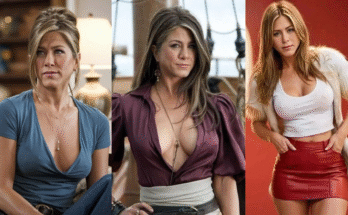The remarkable journey of Robert Lane Saget, from struggling comedian to beloved television father to comedy legend
Introduction: The Man Behind Two Personas
Robert Lane “Bob” Saget lived one of entertainment’s most fascinating double lives—beloved by millions as Danny Tanner, the wholesome single father on “Full House,” while simultaneously maintaining a career as one of comedy’s most irreverent and boundary-pushing stand-up performers. This duality wasn’t an act or a calculated career move; it was the authentic expression of a complex man who understood that life contains both profound sweetness and dark humor, often existing side by side.
Saget’s life story reads like a testament to resilience, authenticity, and the healing power of laughter. From his early years marked by family tragedy to his rise as a television icon, from his struggles with typecasting to his triumphant return to his comedy roots, Saget’s journey illustrates how one person can touch millions of lives while remaining true to their essential nature.
His unexpected death on January 9, 2022, at age 65, sent shockwaves through both the entertainment industry and the countless fans who had grown up with him as a television father figure. Yet his legacy lives on through his groundbreaking work in comedy, his pioneering approach to family entertainment, and his unwavering commitment to using humor as a force for healing and connection.
Chapter 1: Early Life and Formative Experiences (1956-1978)
Philadelphia Beginnings
Robert Lane Saget was born on May 17, 1956, in Philadelphia, Pennsylvania, to Benjamin Morton Saget and Rosalyn “Dolly” Saget. His father worked as a supermarket executive, while his mother served as a hospital administrator—middle-class professionals who instilled in their children the values of hard work, education, and family loyalty that would define Bob’s character throughout his life.
The Saget household was one where humor served as both entertainment and coping mechanism. Bob’s natural inclination toward comedy emerged early, as he discovered that making people laugh could diffuse tension, create connection, and provide relief during difficult moments. This early understanding of comedy’s therapeutic power would become central to his life philosophy and career approach.
Bob was the middle child of three, with an older sister Gay and a younger sister Andrea. The family dynamic was loving but would be marked by profound tragedy that would shape Bob’s worldview and comedy in fundamental ways. These early experiences with love and loss would inform both his protective instincts as a television father and his darker comedic observations about life’s fragility.
Geographic Transitions and Adaptation
When Bob was young, the Saget family relocated to Norfolk, Virginia, where his father’s work had taken them. This move required adaptation and resilience from young Bob, teaching him early lessons about adjusting to new environments and finding his place in unfamiliar social situations—skills that would prove invaluable in his entertainment career.
Later, during Bob’s high school years, the family moved to the Encino area of Los Angeles, California. This relocation to the entertainment capital of the world was coincidental rather than calculated, but it would prove pivotal in Bob’s eventual career path. The move exposed him to the entertainment industry’s presence and possibilities while he was still forming his own ambitions and identity.
These geographic transitions taught Bob about adaptability, the importance of maintaining family connections despite external changes, and the value of finding humor in uncertain situations. These lessons would later influence his approach to both comedy and family life, emphasizing the importance of stability and love as anchors during life’s inevitable changes.
Educational Journey and Early Creative Expression
Bob attended Abington Senior High School in Pennsylvania before the family’s move to California, where he completed his education at Van Nuys High School. During these high school years, he began to seriously explore his interest in entertainment, participating in school productions and developing his comedic voice through various creative outlets.
His academic performance was solid, but his real passion lay in creative expression—whether through comedy, writing, or performance. Teachers and classmates recognized his natural ability to entertain and his genuine desire to make others laugh, qualities that distinguished him from typical class clowns by their underlying empathy and intelligence.
Bob’s high school experience also introduced him to the technical aspects of entertainment production. He developed interests in writing, directing, and the behind-the-scenes elements of creative work that would serve him throughout his career. This broad understanding of entertainment production would later make him a valuable collaborator and creative partner in his various projects.

Temple University and Serious Artistic Development
Bob’s enrollment at Temple University in Philadelphia marked a crucial period in his artistic development. Initially pursuing a degree in documentary filmmaking, he created a black-and-white film about a boy who received facial reconstructive surgery—a project that demonstrated his early interest in finding humor and humanity in serious, potentially painful subjects.
This documentary work revealed Bob’s natural empathy and his ability to approach sensitive topics with both respect and insight. The project showcased his understanding that comedy and drama weren’t opposing forces but could work together to create more complete and honest portrayals of human experience.
During his Temple years, Bob also began performing stand-up comedy in local clubs and venues. His early performances were raw and experimental, as he worked to develop his comedic voice and understand what made audiences respond. These formative performing experiences taught him about timing, audience connection, and the craft elements that separate professional entertainment from amateur attempts.
Early Comedy Development and Influences
Bob’s early comedy was heavily influenced by the observational humor tradition, drawing inspiration from comedians like George Carlin, Richard Pryor, and Lenny Bruce—performers who used comedy to examine society, relationships, and the human condition with unflinching honesty. This influence would shape his approach to finding humor in life’s complexities and contradictions.
His natural comedic instincts leaned toward the observational and storytelling traditions rather than one-liners or prop comedy. He discovered early that his strength lay in finding the absurd within the mundane and helping audiences see familiar experiences from new, often hilarious perspectives.
During this period, Bob also began developing the contrasts that would define his career—his ability to be both wholesome and edgy, both family-friendly and adult-oriented, both sweet and sardonic. These weren’t calculated personas but authentic expressions of his complex personality and worldview.
Chapter 2: The Struggle and Breakthrough Years (1978-1987)
Post-College Reality and Early Professional Challenges
After graduating from Temple University, Bob faced the common challenge of transitioning from student to working professional in the highly competitive entertainment industry. His move to Los Angeles represented both opportunity and uncertainty, as he attempted to establish himself in stand-up comedy while supporting himself through various jobs.
His early years in Los Angeles were marked by the typical struggles of aspiring entertainers—financial uncertainty, frequent rejection, and the challenge of maintaining confidence while facing constant criticism and competition. Bob performed at small clubs, open mic nights, and anywhere else that would give him stage time to develop his craft and build an audience.
During this period, Bob worked various jobs to support himself while pursuing comedy, including retail work and other service industry positions. These experiences provided him with material for his comedy while also teaching him about different aspects of working life that would inform his later portrayals of everyday people and situations.
Stand-Up Comedy Circuit Development
Bob’s progression through the Los Angeles comedy circuit was gradual but steady. He began at the bottom tier of venues, working his way up through the hierarchy of clubs that determined a comedian’s status and earning potential. This process taught him about professionalism, persistence, and the importance of continuously improving his craft.
His comedy style during this period was notably different from his later television persona—edgier, more observational about adult relationships and social dynamics, and often dealing with topics that would be considered inappropriate for family audiences. This contrast would later create interesting tensions and opportunities in his career.
Bob’s reputation among fellow comedians grew as his skills developed. He became known for his work ethic, his willingness to help other performers, and his ability to find humor in situations that others might find merely depressing or frustrating. These qualities helped him build the professional relationships that would prove crucial to his later success.
Early Television Appearances and Recognition

Bob’s first significant television exposure came through appearances on various comedy shows and late-night programs that featured stand-up performers. These appearances were crucial for establishing his reputation beyond the Los Angeles club scene and introducing him to broader audiences who might appreciate his comedic perspective.
His work on shows like “The Merv Griffin Show” and other variety programs provided him with valuable experience in television performance, which required different skills than live stand-up comedy. He learned about timing for television, working with directors and producers, and adapting his material for broadcast standards.
These early television experiences also introduced Bob to the business side of entertainment—negotiations, contracts, and the complex relationships between performers, agents, managers, and production companies. This education would prove valuable throughout his career as he navigated increasingly complex professional opportunities.
“America’s Funniest Home Videos” Opportunity
One of Bob’s most significant career breaks came when he was chosen to host “America’s Funniest Home Videos” in 1989, two years after “Full House” began. This opportunity showcased his ability to work with family-friendly material while maintaining his natural comedic instincts and personality.
The show required Bob to provide commentary on amateur videos submitted by viewers, a format that played to his strengths in observational humor while requiring him to maintain appropriate content standards for family viewing. This balance would become a hallmark of his television work.
“America’s Funniest Home Videos” also provided Bob with national exposure that complemented his “Full House” fame, establishing him as a versatile entertainer who could work in different formats and reach diverse audiences. The show’s success proved his appeal extended beyond sitcom acting to include hosting and variety entertainment.
Personal Life and Relationships During Early Career
During this period, Bob met and married Sherri Kramer in 1982, a relationship that provided him with personal stability during the uncertain early years of his career. Sherri’s support and understanding of the entertainment industry’s demands were crucial during Bob’s professional development.
The couple’s decision to start a family while Bob’s career was still developing required careful balancing of professional ambitions and personal responsibilities. Their first daughter, Aubrey, was born in 1987, the same year “Full House” premiered, creating additional motivation for Bob to succeed in his television career.
Bob’s approach to balancing career and family during this period established patterns that would continue throughout his life—his commitment to being present for important family moments while also dedicating himself fully to his professional responsibilities. This balance would later inform his authentic portrayal of Danny Tanner’s similar challenges.
Chapter 3: Full House Era and Dual Career Management (1987-1995)
Landing the Danny Tanner Role
The audition process for “Full House” represented a turning point in Bob’s career, offering him the opportunity to move from supporting roles and guest appearances to leading man status on a network television series. The role of Danny Tanner required an actor who could convey both strength and vulnerability, authority and warmth—qualities that Bob possessed naturally.
His audition showcased not only his comedic timing but also his ability to convey genuine emotion and paternal authority. The casting directors recognized that Bob’s real-life experience as a father and his natural protective instincts made him ideal for portraying a widowed father trying to raise three daughters while processing his own grief.
The chemistry between Bob and his potential co-stars John Stamos and Dave Coulier was evident from early readings, creating the foundation for the authentic male friendship that would become central to the show’s appeal. Their different comedic styles and personalities complemented each other naturally, suggesting the potential for rich character development.
Balancing Television Personas
One of the most fascinating aspects of Bob’s career during the “Full House” era was his successful management of two very different public personas—the wholesome family man Danny Tanner and the edgy stand-up comedian who continued performing in clubs and comedy specials throughout the show’s run.

This duality required careful navigation of audience expectations and professional opportunities. Bob’s stand-up material during this period often played with the contrast between his television image and his actual comedic sensibilities, creating humor from the disconnect between public perception and private reality.
His ability to maintain authenticity in both roles demonstrated his sophisticated understanding of performance and audience. He never allowed either persona to completely overwhelm the other, instead finding ways to let each inform and enrich his overall artistic expression.
Behind-the-Scenes Leadership and Mentorship
As “Full House” developed, Bob naturally assumed a leadership role among the cast, particularly in his relationships with the child actors who played his television daughters. His genuine care for their wellbeing and professional development created a protective, nurturing environment that enhanced their performances while safeguarding their personal growth.
His mentorship extended beyond the child actors to include guidance and support for his adult co-stars as they navigated the challenges of series television success. Bob’s experience in the entertainment industry and his natural inclination toward helping others made him a valuable resource for the entire cast and crew.
The family atmosphere that developed on the “Full House” set was largely attributable to Bob’s approach to leadership—collaborative rather than hierarchical, supportive rather than competitive, and focused on collective success rather than individual achievement. This environment contributed significantly to the show’s authentic family dynamics.
Personal Life Integration
During the “Full House” years, Bob’s personal life expanded with the birth of his daughters Lara (1989) and Jennifer (1992), creating a household that mirrored in some ways the fictional Tanner family structure. His real-life experiences as a father of three daughters provided authentic emotional reference for his Danny Tanner performances.
The parallels between Bob’s actual family life and his television role created unique opportunities for genuine emotional connection in his performances. His understanding of the joys and challenges of raising daughters informed his portrayal in ways that purely acting technique could not have achieved.
Bob’s commitment to maintaining strong family relationships while managing the demands of television production required careful time management and priority setting. His success in balancing these responsibilities demonstrated the same values that Danny Tanner represented on screen.
Creative Input and Show Development
As “Full House” evolved, Bob became increasingly involved in the creative development of storylines, character arcs, and the show’s overall direction. His input was particularly valuable in ensuring that Danny Tanner’s character remained authentic and that the show’s family dynamics felt genuine rather than manufactured.
His suggestions for storylines often drew from his own experiences as a parent and his observations about family life, contributing to the show’s reputation for addressing real family challenges with both humor and sincerity. This creative involvement enhanced his investment in the show’s success and quality.
Bob’s collaborative approach to creative development helped establish “Full House” as more than just entertainment—it became a resource for families navigating their own challenges and a model for how family members could support each other through difficult times.
Chapter 4: Personal Tragedies and Their Impact (1990s-2000s)
The Loss of Sister Gay
One of the most profound influences on Bob’s life and comedy was the death of his sister Gay from scleroderma, a rare autoimmune connective tissue disease, when she was 47 years old. This loss occurred during the height of his “Full House” success, creating a painful contrast between his public happiness and private grief.
Gay’s battle with scleroderma was lengthy and difficult, requiring Bob to watch someone he loved suffer through a progressive, incurable illness. This experience deepened his understanding of life’s fragility and strengthened his belief in the importance of family support during crisis situations.
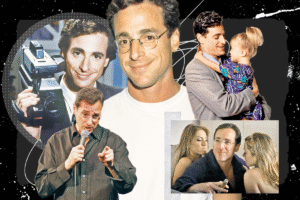
The loss of Gay profoundly influenced Bob’s approach to both comedy and life. He began incorporating more material about loss, grief, and the absurdity of medical situations into his stand-up routines, finding ways to process his pain through humor while also helping audiences deal with their own difficult experiences.
Sister Andrea’s Tragic Death
The subsequent loss of his sister Andrea to a brain aneurysm at age 32 compounded Bob’s grief and further shaped his perspective on life’s unpredictability. Andrea’s sudden death reinforced his understanding that tragedy could strike without warning, making every moment with loved ones precious and irreplaceable.
These back-to-back losses of his sisters created a period of intense personal struggle for Bob, as he worked to maintain his professional responsibilities while processing profound grief. His ability to continue performing and creating during this time demonstrated remarkable resilience and commitment to his craft.
The deaths of both sisters also intensified Bob’s protective instincts toward his own daughters and his “Full House” family. His experiences with loss made him acutely aware of the importance of expressing love regularly and maintaining strong family connections.
Channeling Grief Into Purpose
Rather than allowing these tragedies to overwhelm him, Bob found ways to channel his grief into positive action. He became actively involved with the Scleroderma Research Foundation, using his celebrity status to raise awareness and funds for research into the disease that claimed Gay’s life.
His charitable work provided him with a sense of purpose beyond entertainment, allowing him to honor his sisters’ memories while potentially helping other families avoid similar losses. This philanthropic commitment became a central part of his life mission and public service.
Bob’s openness about his family’s struggles with serious illness helped reduce stigma around discussing medical challenges and demonstrated how public figures could use their platforms to support important causes. His advocacy work influenced many fans to support scleroderma research and other health-related charities.
Impact on Comedy and Performance
These personal tragedies significantly influenced Bob’s comedic voice, adding depth and poignancy to his humor while also introducing darker elements that balanced his wholesome television image. His comedy became more sophisticated in its treatment of serious subjects while maintaining its essential humanity.
His ability to find humor in medical situations, family crises, and grief itself provided audiences with permission to laugh during their own difficult times. This therapeutic approach to comedy became one of Bob’s most valuable contributions to the entertainment industry.
The contrast between his personal struggles and his public persona as America’s dad created rich material for his stand-up routines, as he explored the complexities of maintaining optimism and humor while dealing with profound loss.
Chapter 5: Post-Full House Career Evolution (1995-2010)
Transitioning Away from Family Television
When “Full House” ended in 1995, Bob faced the challenge that many actors encounter when leaving long-running, successful series—how to establish a new professional identity while honoring the work that made them famous. His situation was complicated by the stark contrast between his television persona and his stand-up comedy material.
His decision to continue hosting “America’s Funniest Home Videos” until 1997 provided continuity and income while he developed new projects, but it also reinforced his association with family-friendly entertainment. This association was both an asset and a limitation as he sought to expand his career opportunities.
Bob’s approach to this transition was gradual and strategic, taking on projects that allowed him to demonstrate his range while respecting the loyalty of fans who knew him primarily through “Full House.” This careful balance required rejecting some opportunities that might have damaged his reputation while pursuing others that showcased his versatility.
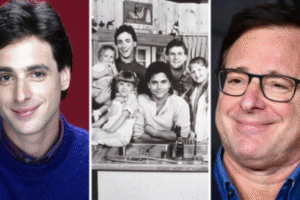
Return to Stand-Up Comedy Roots
After leaving network television, Bob returned to stand-up comedy with renewed energy and perspective. His material had been enriched by his television experiences, his personal losses, and his observations about fame and public perception, creating more sophisticated and nuanced performances.
His comedy during this period often addressed the disconnect between his public image and his actual personality, mining humor from audience expectations and the absurdity of being seen as a wholesome father figure by people who had never met him personally.
These performances allowed Bob to reconnect with his authentic comedic voice while also introducing audiences to aspects of his personality that television hadn’t revealed. The contrast between expectation and reality became a source of both humor and artistic satisfaction.
Directing and Behind-the-Scenes Work
Bob’s directorial debut with the 1998 film “Dirty Work,” starring Norm MacDonald and Artie Lange, demonstrated his ability to work with edgier material while maintaining his fundamental understanding of comedy timing and character development. The film, while not a commercial success, showcased his directorial skills and creative vision.
His work behind the camera provided him with new creative challenges and opportunities to influence projects from conception through completion. This expanded role allowed him to apply his years of television experience to different formats and genres.
The experience of directing also deepened Bob’s appreciation for the collaborative nature of entertainment production and strengthened his relationships with other comedy professionals who appreciated his supportive approach to creative work.
Marriage Challenges and Personal Growth
Bob’s marriage to Sherri Kramer ended in divorce in 1997, a personal setback that occurred during his professional transition period. The divorce was amicable and focused on maintaining positive relationships for the sake of their three daughters, but it nonetheless represented a significant life change.
His approach to co-parenting after divorce demonstrated the same commitment to family stability that had characterized his “Full House” persona. He worked to ensure that his daughters maintained strong relationships with both parents and felt secure despite the family structure changes.
This period of personal upheaval also provided Bob with new material for his comedy, as he explored the challenges of middle-aged dating, single parenthood, and maintaining optimism during difficult life transitions.
Television Guest Appearances and Character Development
During the 2000s, Bob made strategic guest appearances on various television shows that allowed him to explore different types of characters while trading on his established reputation. His appearances on shows like “Entourage” were particularly notable for playing exaggerated versions of himself.
These self-referential performances demonstrated Bob’s willingness to examine his own public image with humor and intelligence. His ability to mock his own reputation while maintaining essential dignity showed sophisticated understanding of celebrity and performance.
His work as the narrator on “How I Met Your Mother” brought his career full circle, as he once again became the voice of a father figure telling family stories, but with a more mature and complex perspective than his “Full House” character had possessed.
Chapter 6: Later Career Renaissance and Legacy Building (2010-2022)
“The Aristocrats” and Comedy Documentary Work
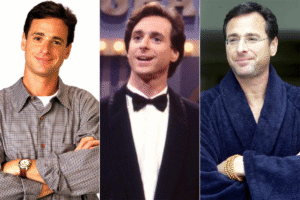
Bob’s participation in the documentary “The Aristocrats” (2005) marked a significant moment in his career, as it showcased his ability to perform extremely adult material while demonstrating his deep knowledge of comedy history and technique. The film revealed aspects of his comedic personality that mainstream audiences had never seen.
His version of the infamous joke demonstrated his storytelling abilities and his understanding of comedy’s transgressive potential. This performance helped bridge the gap between his family-friendly image and his adult comedy sensibilities, showing audiences that both were authentic expressions of his personality.
The documentary’s success helped establish Bob as a serious student of comedy and a respected voice within the comedy community. His contributions were praised by fellow comedians who appreciated his technical skills and his commitment to the craft.
Stand-Up Specials and Comedy Central Work
Bob’s comedy specials during this period, including “That Ain’t Right” (2007) and “That’s What I’m Talkin’ About” (2013), showcased his fully developed comedic voice and his ability to address adult themes while maintaining his essential warmth and humanity.
These specials allowed audiences to see Bob’s complete comedic range, from observational humor about family life to more controversial material about relationships, aging, and social dynamics. The contrast with his television image created additional layers of humor and authenticity.
His work with Comedy Central and other networks demonstrated that his appeal extended beyond nostalgia for “Full House” to include appreciation for his skills as a contemporary comedian addressing current social and personal issues.
Podcasting and New Media Exploration
Bob’s embrace of podcasting and new media platforms allowed him to connect with audiences in more intimate and unfiltered ways than traditional television permitted. His podcast work showcased his interviewing skills and his genuine interest in other people’s stories and perspectives.
These platforms provided Bob with creative freedom to explore topics and formats that wouldn’t fit traditional television structures. His conversations with fellow comedians, actors, and other entertainment professionals revealed his thoughtful approach to creativity and collaboration.
The podcast format also allowed Bob to address his family tragedies and personal challenges more directly than his previous work had permitted, creating deeper connections with audiences who appreciated his honesty and vulnerability.
Return to Full House Universe
Bob’s participation in “Fuller House” represented both a homecoming and a new challenge, as he reprised Danny Tanner while incorporating the wisdom and experience he had gained in the intervening years. His performance showed how the character could evolve while maintaining essential qualities.
His work as an executive producer on the reboot demonstrated his business acumen and his commitment to maintaining the quality and values that had made the original series successful. His behind-the-scenes involvement ensured continuity with the original while addressing contemporary family challenges.
The success of “Fuller House” validated Bob’s belief that family entertainment could remain relevant and meaningful when it addressed real challenges with honesty and humor. His contribution to the reboot’s success demonstrated his continued value as both performer and creative collaborator.
Personal Life Stability and New Relationships
Bob’s marriage to Kelly Rizzo in 2018 represented a new chapter in his personal life, providing him with companionship and stability during his later career years. Kelly’s understanding of the entertainment industry and her own media career created a foundation for mutual support and understanding.
Their relationship demonstrated Bob’s continued capacity for growth and his commitment to building meaningful personal connections despite the challenges of public life and career demands. Kelly’s presence in his life appeared to enhance his happiness and creative productivity.
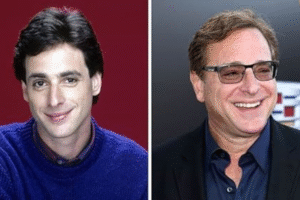
Bob’s relationship with his daughters also evolved during this period, as they became adults with their own careers and perspectives. His pride in their achievements and his continued involvement in their lives demonstrated the success of his parenting approach.
Final Projects and Creative Legacy
Bob’s final projects included continued stand-up touring, podcast work, and various television appearances that showcased his enduring appeal and relevance. His energy and enthusiasm for performing remained strong even as he entered his sixties.
His commitment to live performance was evident in his extensive touring schedule, which brought him into direct contact with audiences who appreciated both his nostalgic value and his contemporary relevance. These performances demonstrated his continued passion for the craft of comedy.
Bob’s final creative works reflected a man who had successfully integrated all aspects of his personality and experience into a coherent artistic vision. His ability to be simultaneously wholesome and edgy, nostalgic and contemporary, demonstrated the complexity that had always characterized his best work.
Conclusion: The Enduring Legacy of Bob Saget
The Sudden Loss and Industry Response
Bob Saget’s unexpected death on January 9, 2022, in an Orlando hotel room while on tour shocked the entertainment industry and millions of fans worldwide. The cause was later determined to be blunt head trauma, likely from an accidental fall, highlighting the tragic irony that such a vibrant, life-affirming performer could be lost so suddenly.
The outpouring of grief and tribute from fellow comedians, actors, and fans demonstrated the profound impact Bob had made on countless lives through his work and personal relationships. The testimonials revealed consistent themes: his kindness, his mentorship, his professional generosity, and his ability to find humor in life’s darkest moments.
His “Full House” family’s responses to his death particularly illustrated the genuine bonds that had been formed during their years together. Their grief was clearly personal rather than merely professional, confirming that the family atmosphere of the show had been authentic rather than manufactured.
Artistic and Cultural Impact
Bob Saget’s career demonstrated that entertainers could successfully maintain multiple creative identities without compromising their authenticity. His ability to be both wholesome and edgy, both mainstream and alternative, created a template for other performers seeking to avoid typecasting while honoring their established successes.
His approach to family entertainment helped establish new standards for shows that could address serious topics while maintaining optimistic outlooks. “Full House” became a model for how television could provide both entertainment and guidance for families navigating real-world challenges.
His stand-up comedy contributed to the evolution of observational humor, particularly in its treatment of family life, parenting, and the absurdities of modern existence. His ability to find humor in personal tragedy without minimizing its impact influenced many subsequent comedians.
Philanthropic and Personal Legacy
Bob’s charitable work, particularly his advocacy for scleroderma research, created lasting impact beyond entertainment. His efforts helped raise both funds and awareness for a rare disease that might otherwise have received limited attention from celebrity advocates.
His approach to using fame for positive purposes provided a model for how public figures could leverage their platforms to address serious issues without compromising their entertainment careers. His charitable work was genuine rather than performative, reflecting his authentic commitment to helping others.
The relationships Bob built throughout his career—with fellow performers, industry professionals, and fans—demonstrated his fundamental decency and his understanding that success meant nothing without meaningful human connections.
Lessons and Inspiration
Bob Saget’s life story offers valuable lessons about resilience, authenticity, and the healing power of humor. His ability to process personal tragedy through comedy while maintaining optimism and compassion provides inspiration for others facing similar challenges.
His career demonstrates that success can be achieved without compromising personal values or authentic identity. His refusal to choose between his wholesome and edgy sides showed that complexity is strength rather than weakness.
Most importantly, Bob’s life illustrated that the greatest legacy anyone can leave is the positive impact they have on other people’s lives. Through his entertainment, his mentorship, his charitable work, and his personal relationships, Bob Saget touched countless lives in meaningful ways.
His story reminds us that laughter truly can be the best medicine, that family bonds can overcome any challenge, and that kindness and humor can transform even the darkest experiences into sources of connection and healing. In these ways, Bob Saget’s legacy continues to inspire and comfort, ensuring that his impact will endure far beyond his final performance.
Bob Saget was more than America’s dad—he was America’s reminder that it’s possible to maintain hope, find humor, and spread love even in the face of life’s greatest challenges. That may be the most valuable lesson of all.



